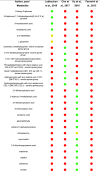Metabolomic approach for obstructive sleep apnea in adults: a systematic review
- PMID: 38469078
- PMCID: PMC10899929
- DOI: 10.1007/s41105-023-00445-5
Metabolomic approach for obstructive sleep apnea in adults: a systematic review
Erratum in
-
Correction: Metabolomic approach for obstructive sleep apnea in adults: a systematic review.Sleep Biol Rhythms. 2023 Jul 13;21(4):473. doi: 10.1007/s41105-023-00475-z. eCollection 2023 Oct. Sleep Biol Rhythms. 2023. PMID: 38476187 Free PMC article.
Abstract
Obstructive Sleep Apnea (OSA) corresponds to episodes of complete or partial upper airway obstruction during sleep. The gold standard for diagnosing OSA is polysomnography; however, metabolomics is an innovative and highly sensitive method that seeks to identify and quantify small molecules in biological systems. Identify the metabolites most frequently associated with obstructive sleep apnea in adults. The search for articles was conducted between October 2020 and August 2021, in electronic databases, such as MEDLINE/PubMed, Scielo, Embase, and Cochrane, through the combination of descriptors: obstructive sleep apnea, metabolomic, adult. This systematic review included all cross-sectional studies published, including human patients aged 18 years or older, of both genders who underwent type I or II polysomnography and metabolomics study. The search strategy selected 3697 surveys, and 4 of them were selected to be a part of this systematic review. Based on the analyzed surveys, it was found that all of them were able to diagnose OSA, reaching a sensitivity of 75-97%, and specificity that ranged from 72 to 100%; besides differentiating patients with OSA (severe, moderate, and mild) from simple snorers with a mean sensitivity of 77.2% and specificity of 66.25%. These findings suggest that, in addition to being used as a screening and diagnostic strategy for OSA, metabolomics has the potential to be used for severity stratification and to monitor the disease's progression.
Keywords: Adults; Metabolomic; Obstructive sleep apnea.
© The Author(s), under exclusive licence to Japanese Society of Sleep Research 2023, corrected publication 2023. Springer Nature or its licensor (e.g. a society or other partner) holds exclusive rights to this article under a publishing agreement with the author(s) or other rightsholder(s); author self-archiving of the accepted manuscript version of this article is solely governed by the terms of such publishing agreement and applicable law.
Conflict of interest statement
Conflict of interestThe authors declare that they have no conflict of interest.
Figures





Similar articles
-
[Validation of NoSAS Score and Obstructive Sleep Apnea Hypopnea Syndrome Screening Model for Female Snorers in Females with Obstructive Sleep Apnea].Zhongguo Yi Xue Ke Xue Yuan Xue Bao. 2019 Dec 30;41(6):825-831. doi: 10.3881/j.issn.1000-503X.11131. Zhongguo Yi Xue Ke Xue Yuan Xue Bao. 2019. PMID: 31907135 Chinese.
-
Comparison of anatomic and aerodynamic characteristics of the upper airway among edentulous mild, moderate, and severe obstructive sleep apnea in older adults.J Clin Sleep Med. 2022 Mar 1;18(3):759-768. doi: 10.5664/jcsm.9716. J Clin Sleep Med. 2022. PMID: 34636319 Free PMC article.
-
Point-of-Care Ultrasound for Obstructive Sleep Apnea Screening: Are We There Yet? A Systematic Review and Meta-analysis.Anesth Analg. 2019 Dec;129(6):1673-1691. doi: 10.1213/ANE.0000000000004350. Anesth Analg. 2019. PMID: 31743189
-
Association of obstructive sleep apnea and nocturnal hypoxemia with all-cancer incidence and mortality: a systematic review and meta-analysis.J Clin Sleep Med. 2022 May 1;18(5):1427-1440. doi: 10.5664/jcsm.9772. J Clin Sleep Med. 2022. PMID: 34755597 Free PMC article.
-
Clinical Practice Guideline for Diagnostic Testing for Adult Obstructive Sleep Apnea: An American Academy of Sleep Medicine Clinical Practice Guideline.J Clin Sleep Med. 2017 Mar 15;13(3):479-504. doi: 10.5664/jcsm.6506. J Clin Sleep Med. 2017. PMID: 28162150 Free PMC article.
Cited by
-
A Preliminary Integrated Metabolomics Analysis Identifies Retrograde Endocannabinoid Signaling Shift in Severe OSA Patients.Sleep Breath. 2025 Jul 31;29(4):259. doi: 10.1007/s11325-025-03425-w. Sleep Breath. 2025. PMID: 40742621 Free PMC article.
References
-
- American Academy of Sleep Medicine. International Classification of Sleep Disorders: Diagnostic and Coding Manual. 2005;
Publication types
LinkOut - more resources
Full Text Sources
